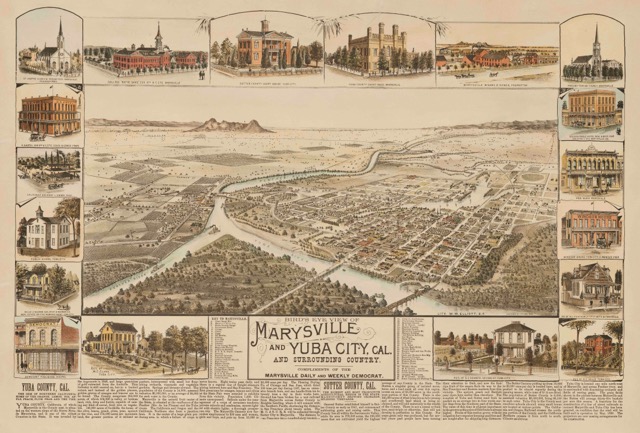
Lithograph of Yuba City and Marysville, 1851. The Feather River flows from the upper right to the bottom left. The Yuba River flows from the bottom right to join the Feather. Courtesy of the California State Library, Sacramento.
The greater Yuba City area lies in the farming heartland of the northern Sacramento Valley about 110 miles northeast of San Francisco. The area includes the twin cities of Yuba City and Marysville. Both Yuba and Sutter Counties are still rural with agriculture remaining the backbone of the local economy. The population of Yuba City is approximately 65,000. The land is extremely productive, especially for growing cling peaches, grapes, walnuts, rice, and plums. The one feature setting the Yuba City area apart from the surrounding rural areas is the presence of the largest rural Punjabi community outside of the Indian subcontinent.
History of the Yuba City Area
The native American tribe, the Maidu, lived in the area for centuries. In 1841, after building Sutter’s Fort, John Augustus Sutter established Hock Farm on the bank of the Feather River, near present-day Yuba City. Hock Farm was the first major agricultural project in Northern California. The area prospered during the Gold Rush as it served as a site where miners would disembark from river boats on the Sacramento River on their way to prospect for gold in the Sierras. Marysville is named after one of the survivors of the Donner Party, Mary Murphy. Sutter County is bound by three rivers: the Feather River on the east, the Sacramento River on the west, and the Bear River on the south, with the Sutter Buttes prominent in the center. Historically, the region was subject to periodic and often devastating floods. The area is well-known for propagating the Thompson seedless grape.
Historically, the towns in the areas were hostile to Asian immigrants. Marysville was home to a large Chinese immigrant community until 1886, when the residents drove out all of the Chinese immigrants from their town as part of a broad wave of anti-Chinese sentiment in California. In the early twentieth century when Punjabi immigrants began to move into the area, they also were also met with hostility. On January 27, 1908, the residents of Marysville drove the Punjabi pioneers out of town. In contrast, today the Yuba City area is a remarkably diverse community, including residents of European, Mexican, Vietnamese, Japanese, Korean, Hmong, Middle Eastern, and of course, Punjabi heritage. Moreover, Punjabi Americans are highly influential in agriculture, and in the political, professional, and cultural life of the community.
“Chota Punjab” (Yuba City is referred to as the “Little Punjab” by Punjabis)
Approximately 15,000-18,000 Punjabi Americans reside in the greater Yuba City area today. In contrast to the South Asian immigrant neighborhoods in major US cities (Flushing, New York; the area near Devon Avenue in Chicago; and Sunnyvale in the Bay Area), the Punjabi American community is not contained within an immigrant neighborhood. Instead, Punjabi American families live in their own homes and ranches on prime land throughout the area. Their decisions about where to purchase property are primarily determined by their assessment of the best quality and type of land required to successfully cultivate particular crops. According to La Brack, the Punjabis purchase their farms in a highly productive stretch of land, the so-called “fertile crescent,” extending in the North from Live Oak though the Yuba City area and south another twelve miles. Generally, the pattern of land ownership among Punjabi farmers in the Yuba City area falls within three miles in proximity to the Feather and Yuba rivers where the soil is optimal for growing peaches, walnuts, and plums. Due to their success in farming and their ability to sponsor relatives from India in large numbers, the Punjabi community grew rapidly from the 1960s to the present. Today Punjabi Americans are among the most successful farmers in the community, and they are also well-represented in every sphere of professional and public life. The Punjabi American community is most visible during the Sikh parade during the first weekend in November that attracts 100,000 people from far away to the area — the parade’s route traverses 4.5 miles through the heart of the community.
SOURCE:
La Brack, Bruce. The Sikhs of Northern California (New York: AMS Press, 1988).
